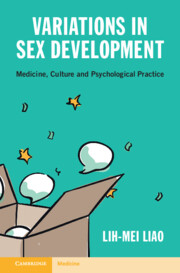Refine search
Actions for selected content:
18 results
Dimensions of donation preferences: the structure of peer and income effects
-
- Journal:
- Experimental Economics / Volume 24 / Issue 1 / March 2021
- Published online by Cambridge University Press:
- 14 March 2025, pp. 274-302
-
- Article
- Export citation
Chapter 5 - Advocacy, Public Engagement and Healthcare Reform
- from Section 2 - Medicalization and Resistance
-
- Book:
- Variations in Sex Development
- Published online:
- 18 November 2022
- Print publication:
- 08 December 2022, pp 60-80
-
- Chapter
- Export citation

Variations in Sex Development
- Medicine, Culture and Psychological Practice
-
- Published online:
- 18 November 2022
- Print publication:
- 08 December 2022
Altruistic Organ Donation: On Giving a Kidney to a Stranger
-
- Journal:
- Cambridge Quarterly of Healthcare Ethics / Volume 31 / Issue 3 / July 2022
- Published online by Cambridge University Press:
- 28 July 2022, pp. 395-399
-
- Article
- Export citation
Curation of the John and Phil Palmquist Archaeological Collection: Implementing SAA “Responsible and Responsive Stewards” Best Practices
-
- Journal:
- Advances in Archaeological Practice / Volume 10 / Issue 1 / February 2022
- Published online by Cambridge University Press:
- 21 December 2021, pp. 91-100
-
- Article
-
- You have access
- Open access
- HTML
- Export citation
Do nudges crowd out prosocial behavior?
-
- Journal:
- Behavioural Public Policy / Volume 8 / Issue 1 / January 2024
- Published online by Cambridge University Press:
- 26 March 2021, pp. 107-120
-
- Article
-
- You have access
- Open access
- HTML
- Export citation
Conclusion
-
- Book:
- The Purchase of the Past
- Published online:
- 01 June 2020
- Print publication:
- 25 June 2020, pp 286-300
-
- Chapter
- Export citation
4 - Salvaging the Gothic in Private and Public Spaces (c.1820–1870)
-
- Book:
- The Purchase of the Past
- Published online:
- 01 June 2020
- Print publication:
- 25 June 2020, pp 159-202
-
- Chapter
- Export citation
The Hidden Wounds of Hurricane Dorian: Why Emergency Response Must Look Beyond Physical Trauma
-
- Journal:
- Disaster Medicine and Public Health Preparedness / Volume 13 / Issue 5-6 / December 2019
- Published online by Cambridge University Press:
- 02 January 2020, pp. 1092-1094
-
- Article
- Export citation
Having a secret reduces charitable giving
-
- Journal:
- Journal of Pacific Rim Psychology / Volume 14 / 2020
- Published online by Cambridge University Press:
- 26 February 2020, e9
- Print publication:
- 2020
-
- Article
-
- You have access
- Open access
- HTML
- Export citation
LO66: Solid organ donation from the emergency department: A death review
-
- Journal:
- Canadian Journal of Emergency Medicine / Volume 21 / Issue S1 / May 2019
- Published online by Cambridge University Press:
- 02 May 2019, pp. S31-S32
- Print publication:
- May 2019
-
- Article
-
- You have access
- Export citation
Legacies of Altruism: Richard Titmuss, Marie Meinhardt, and Health Policy Research in the 1940s
-
- Journal:
- Social Policy and Society / Volume 18 / Issue 3 / July 2019
- Published online by Cambridge University Press:
- 22 April 2018, pp. 383-392
- Print publication:
- July 2019
-
- Article
- Export citation
SUPPORTING LOCAL FOOD SYSTEM DEVELOPMENT THROUGH FOOD PRICE PREMIUM DONATIONS: A POLICY PROPOSAL
-
- Journal:
- Journal of Agricultural and Applied Economics / Volume 48 / Issue 2 / May 2016
- Published online by Cambridge University Press:
- 31 May 2016, pp. 192-217
-
- Article
-
- You have access
- Open access
- HTML
- Export citation
Happy taxation: increasing tax compliance through positive rewards?
-
- Journal:
- Journal of Public Policy / Volume 36 / Issue 3 / September 2016
- Published online by Cambridge University Press:
- 15 October 2015, pp. 381-406
-
- Article
- Export citation
‘I’m not Really Read up on Genetics’: Biobanks and the Social Context of Informed Consent
-
- Journal:
- BioSocieties / Volume 1 / Issue 2 / June 2006
- Published online by Cambridge University Press:
- 23 July 2016, pp. 251-262
- Print publication:
- June 2006
-
- Article
- Export citation
Guidelines for the Use of Foreign Field Hospitals in the Aftermath of Sudden-Impact Disaster
-
- Journal:
- Prehospital and Disaster Medicine / Volume 18 / Issue 4 / December 2003
- Published online by Cambridge University Press:
- 28 June 2012, pp. 278-290
- Print publication:
- December 2003
-
- Article
- Export citation
WHO Concept of Training and Education in Transfusion Medicine
-
- Journal:
- Prehospital and Disaster Medicine / Volume 18 / Issue S1 / March 2003
- Published online by Cambridge University Press:
- 17 February 2017, p. S37
- Print publication:
- March 2003
-
- Article
-
- You have access
- Export citation
Five Decades of Voluntary Blood-Donation Service
-
- Journal:
- Prehospital and Disaster Medicine / Volume 18 / Issue S1 / March 2003
- Published online by Cambridge University Press:
- 17 February 2017, p. S35
- Print publication:
- March 2003
-
- Article
-
- You have access
- Export citation
